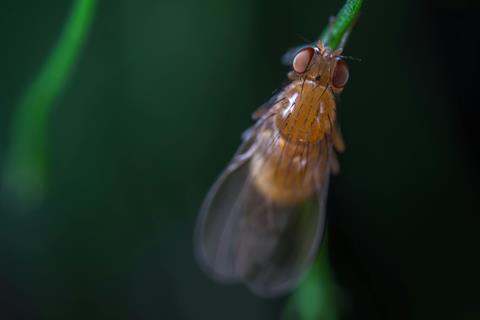Researchers have revealed that the presence of Nora virus in fruit flies can increase their sensitivity to bacterial infection and could limit their lifespan.

The study, published as a Reviewed Preprint in eLife, is described by the editors as important work with convincing data supporting new insights into virus-host interactions in the Drosophila gut. They add that the findings serve as a warning for scientists who use fruit flies as a model to study gut physiology.
READ MORE: A rapid and reproducible method for generating germ-free Drosophila melanogaster
READ MORE: Researchers uncover role of Cul3/Diap2/Dredd axis in mediating the host antimicrobial immune defense
Nora virus is an insect-specific intestinal pathogen that primarily affects fruit flies. It commonly infects laboratory stocks of fruit flies, where it establishes persistent infections, often without causing severe symptoms. The Nora virus can be used as a model to study viral infections in insects.
“We’d previously noted that two different laboratory stocks of fruit flies had remarkably different sensitivity to the bacterium, Pseudomonas aeruginosa, and the only discernible difference was the presence of Nora virus in the more sensitive flies,” says senior author Dominique Ferrandon, Senior Researcher and group leader at the CNRS Immune Response and Development in Insects lab, Institut de Biologie Moléculaire et Cellulaire, Strasbourg, France. “We wondered whether having a persistent Nora virus infection could influence the outcomes of a secondary pathogenic bacterial infection.”
Gut stem cells
To test this, the team measured the growth of gut stem cells which multiply quickly in response to infection. They found that Nora virus-positive flies had three times the rate of stem cell growth compared to flies without the viral infection – suggesting the virally infected flies were more susceptible to the bacteria. Moreover, when they treated flies to eradicate the virus, these flies had a normal lifespan and were less susceptible to the bacteria. However, when virus-negative flies were incubated in tubes that previously housed flies infected with the virus, they soon became infected and sensitive to the bacteria again. The researchers saw similar results when uninfected flies were exposed to purified virus – flies with Nora virus were much more susceptible to the bacteria and died much sooner than the virus-negative flies.
Knowing that both diet and microbiome can influence gut infections, the team next explored the role of these factors on flies with and without Nora virus. They found that flies fed with a richer food (containing extra yeast) had a higher Nora virus load after they had been infected with Pseudomonas aeruginosa (P. aeruginosa) and also died sooner. However, the microbiome only partially accounted for the differences seen under the two feeding conditions, suggesting that other factors were at play.
Interestingly, older flies aged 30–35 days – which tend to have a dysregulated gut microbiome and compromised intestinal barrier – had a fourfold higher burden of Nora virus than younger flies aged 3–5 days old. This increase was also associated with higher stem cell division rates.
Intestinal barrier
As the increased growth of stem cells can indicate repair to a damaged intestinal wall, the team next explored whether P. aeruginosa passed more easily across the intestinal barrier in the Nora virus-positive flies compared with Nora virus-free flies. Indeed, the movement of the bacteria across the intestine was much higher in the viral infected flies and was accompanied by a detectable immune response.
To explore this further, they used an antibody to study the virus’ location within intestinal cells. This suggested that the virus primarily infects the gut stem cells and remains latent, but in response to stress (such as P. aeruginosa infection), the stem cells multiply, reactivating the virus and allowing it to grow within the cells that line the gut wall. In turn, this damages the intestinal wall and reduces the flies’ lifespan.
Nora virus
“Our study finds a low level of Nora virus infection in young fruit flies, which can be activated by age, food nutritional value, and pathogenic infection of the gut,” concludes lead author Adrien Franchet, formerly of the Institut de Biologie Moléculaire et Cellulaire, and now a postdoctoral scientist at the Francis Crick Institute, London, UK. “Our results add to the evidence that intestinal viruses may confound studies of ageing and intestinal physiology in fruit flies, and generally any study that involves monitoring the survival of flies for periods beyond eight days.”
“A sensitive test for Nora virus detection in dissected guts of aged flies is needed to ensure the integrity and reproducibility of fruit fly experiments,” adds Ferrandon. “It will be interesting in the future to understand why only gut stem cells get infected and not the major epithelial cell type in the gut epithelium. This study gives a hint at a possible defective antiviral response in the stem cells.”







No comments yet